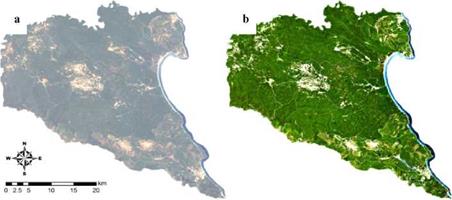Suitable remotely sensed data, classification systems, available classifier and number of training samples are prerequisites for a successful classification. Cingolani et al. (2004) identified three major problems when medium spatial resolution data are used for vegetation classifications: i) defining adequate hierarchical levels for mapping, ii) defining discrete land-cover units discernible by selected remote-sensing data, and iii) selecting representative training sites. In general, a classification system is designed based on the user’s need, spatial resolution of selected remotely sensed data, compatibility with previous work, image-processing and classification algorithms, and time constraints. Such a system should be informative, exhaustive, and separable (Jensen 1996, Landgrebe 2003). In many cases, a hierarchical classification system is adopted to take different conditions into account (Lu and Weng 2007).
4.1 Image pre-processing
Image pre-processing includes geometric correction or image registration, atmospheric correction and radiometric calibration essentially. In addition, topographic correction and noise reduction may be applied if necessary. Optical images from current systems have already corrected geometrically (Landsat TM/ETM, MODIS) or can be corrected using freely available software or tools (e. g. BEAM for MERIS and CHRIS and MRT toolbox for MODIS).
Accurate geometric rectification or image registration of remotely sensed data is a prerequisite for a combination of different source data in a classification process. Many textbooks and articles have described this topic in detail (Jensen 1996, Toutin 2004). However, Geometric correction output should have the transformation rms. errors (RMSE) less than 1.0 pixel, indicating that the images are located with an accuracy of less than a pixel.
Atmospheric and radiometric corrections may not be necessary if a single image is used, but multitemporal or multisensor data are needed atmospheric and radiometric correction and calibration. A variety of methods, ranging from simple relative calibration such as, dark – object subtraction to calibration approaches based on complex models (e. g. MODTRAN, 6S,
ATCOR2), have been developed for radiometric and atmospheric normalization and correction (Chavez 1996, Heo and FitzHugh 2000, Hadjimitsis et al. 2004, Ozyavuz et al. 2011) (Figure 2).
|
Fig. 2. (a) Non-corrected data, (b) Atmospherically corrected and haze removed Landsat TM data using ATCOR2 model (Ozyavuz et al. 2011) |




